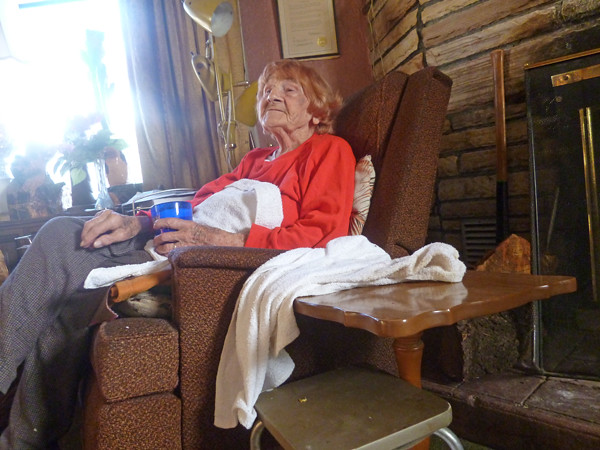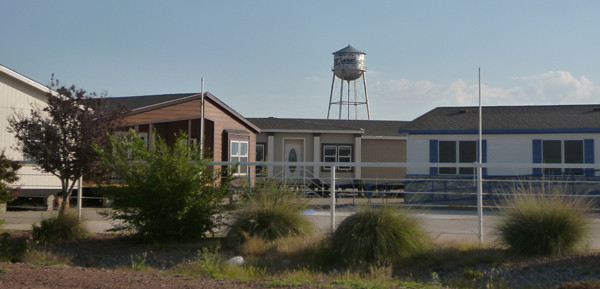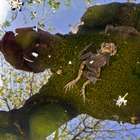Field Trip: New Mexico
Posted Oct. 11, 2012 by Theun KarelseMountains along the highway.
Due to the relatively short amount of time at our disposal, we decide to focus on visiting only two places, and just see what we encounter getting there. The landscape itself is our main interest so we we are guided by geology. First target, the White Sands in the south of New Mexico; second target, the Tent Rocks up north.
Small desert town.
The White Sands is an area of over 400 square kilometres of dunes, and includes a missile range. The dunes consist not of sand but of gypsum and calcium sulfate, so they are brilliantly white. Our way lies south and we drive through vast deserts, and come to a huge bird sanctuary en route. The birds make very unusual sounds and the gardens around the info centre have beautiful cacti and desert plants.
Plant at the bird sanctuary.
The highway crosses some awesome terrain, suddenly going straight through what looks to be a giant licorice stream. This amazing lava landscape isn't even marked on the map, and so further investigation is needed. Cacti and yuccas are living all over this solid black river, floating like seabirds on its dark frozen waves. When you climb it, the material feels like glass.
Climbing the edge of the black lava field.
Just an hour's drive onwards and the mountains start; they are covered ever-more densely with pine forest. The owner of a hardware shop recommended this route and it was a good suggestion. In a forgotten sky resort we chance upon a somewhat derelict motel-inn. But it claims budget prices, so we stop. In a chaotic living room the owner is stirring a pot of soup. Remarkably, the landlady turns out to be a hunchbacked old lady. Born before World War I, she has many stories to tell about the village and her travels abroad; to China and even the USSR before the fall of the Berlin Wall. Our host is resilience personified and maintains her health through a very ingenious rocking chair system.
Last year's forest fires have partially cleared the hills. Yellow flowers now grow there.
The owner of the Alpine Lodge in her rocking chair.
White Sands on the horizon.
Next morning we head towards White Sands. It appears on the horizon as a thin white line trembling in the hot desert air. On approach the dunes become visible, looking like giant white slugs moving through the prairie. A single road leads to the heart of this white sea. Cocky is planning to use some mylar to experiment in this unearthly environment. Its terrifically quiet here. There is life, judging by various footprints in the sand, and every now and then a butterfly passes. But where is that guy going to find food or shelter here!? It's blistering hot and you really need a hat and sunglasses. Sometimes an explosion, probably from the missile range, breaks the silence. We spend a few hours working in the dunes.
The astroblazed dunes.
Making shapes in the wind. Mylar really fits this place.
In the evening we pass Las Cruces, on the way to Mesilla – another tip from the guy in the hardware store. We take a short drive around the village looking for food. Along the road stands what looks like a tennis-ball tree! What appear to be tennis balls are in fact wrinkly fruit that look and smell quite edible. On this same road, cotton is also grown! Wow! The cotton plant has hard shells which break apart and release a small cloud of white fur. We take a few of these too. We end up parking next to an open door, and hearing voices, we decide to go in. It turns out this village has an amazing hidden restaurant – and we just got in through the back door. It has taken over almost all the buildings in this street, and is beautifully decorated. If ever you're somewhere close, you'll need to visit La Posta de Messila.
The tennis-ball tree.
The fruits are wrinkly.
The next day is spent driving all the way back up the state just past Albuquerque. Armalillo is close to several Indian reserves. The whole situation between the native and current inhabitants feels like an unfinished story, and it is a factor that is always present here.
The pueblos the indians live in differ drastically from newer settlements. More plants, more animals and no roads, you just drive anywhere you want. An Indian patrol car drives around making sure visitors take no pictures: it is against their religious beliefs. People work their small plots of land trying to grow various crops, and teams of villagers of all ages walk along the hill roads, clearing trash.
Hiking through the Tent Rocks.
Up north close to the pueblos are the Tent Rocks. These must have been sacred grounds and passages. The hills have eroded away, leaving a curved landscape. You can actually hear geology taking place, as rocks tumble down the slopes. The place is full of birds. A long hike takes you between the narrow winding walls up to the top of the mountain. It looks like a sci-fi movie landscape. (And it's amazing some of the fat tourists don't get trapped in the narrow passages up here.)
Panoramic view of the Tent Rocks.
The next day is spent in Santa Fe, the most European city we've seen here. Food is great. Very nice single-gear bike shops too. But we need to get back. There is only just time to revisit the Balloon Museum and see if the museum shop has some literature on balloon construction. The shop isn't quite what we'd hoped, but while talking to the people at the counter we show some of Cocky's work. They are very enthusiastic; other people are called in who in turn call others, and soon we are talking to the head curator of the museum. She really likes the work, and has some excellent ideas too.
Some generic town up North.
After that we return the car, visit the university campus and prepare for the flight back home. At the campus bookstore we find a small bookle entitled Research is Ceremony, by Shawn Wilson. It is an inspiring exploration of indigenous research methods.
Created: 15 Jul 2021 / Updated: 15 Jul 2021















